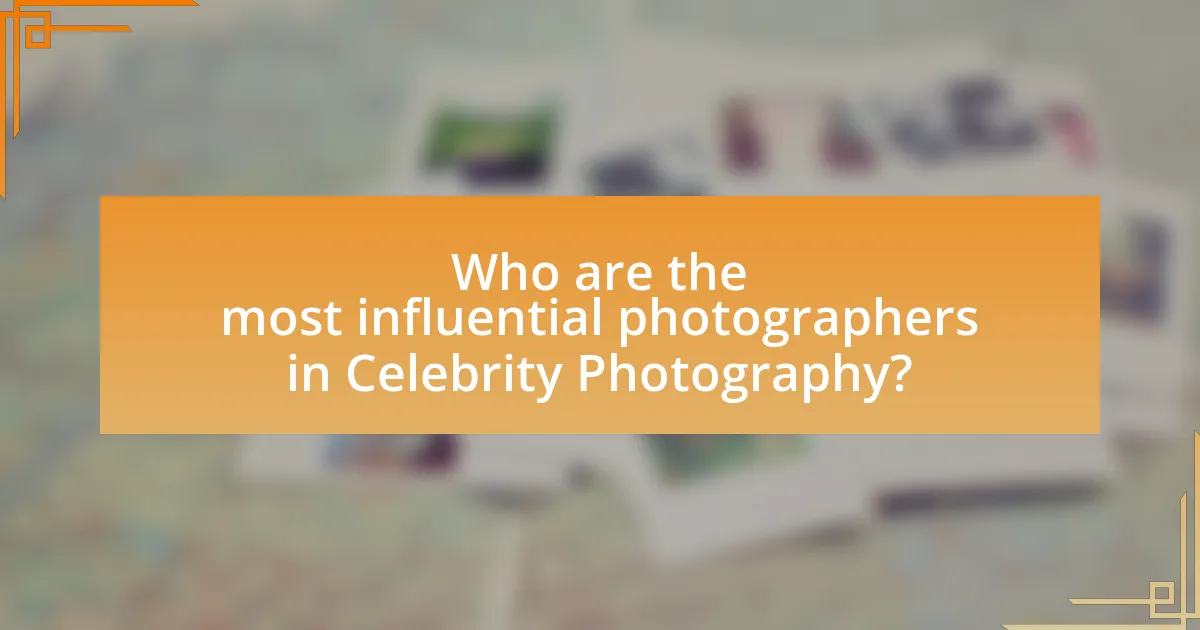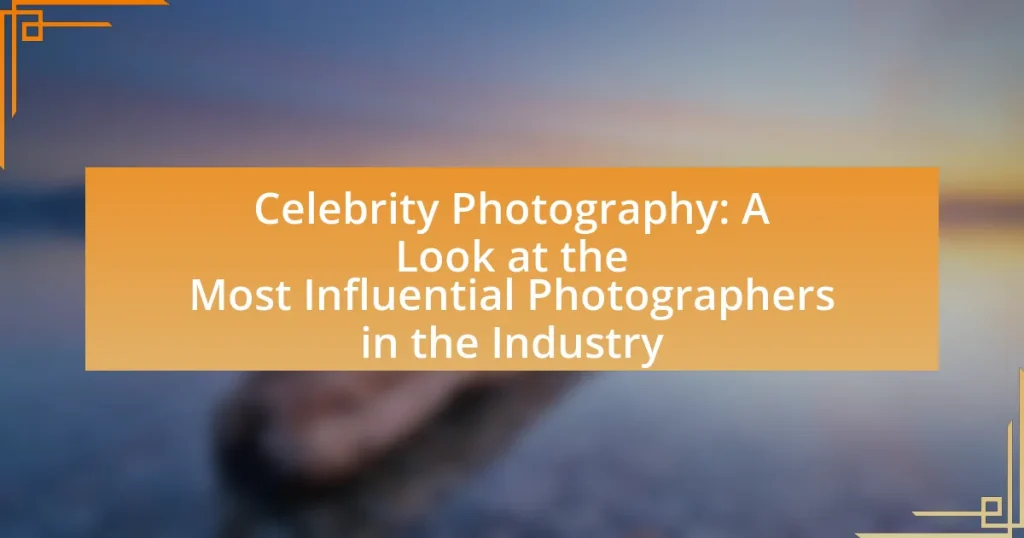Celebrity photography is a specialized genre that captures images of famous individuals, including actors, musicians, and public figures, often portraying their personality and lifestyle. The article explores the evolution of celebrity photography, influenced by historical events and technological advancements, highlighting its significance in shaping public perception and marketing within the entertainment industry. It discusses the contributions of influential photographers such as Annie Leibovitz, Richard Avedon, and Mario Testino, detailing their unique styles and techniques. Additionally, the article outlines essential skills for aspiring photographers, best practices for capturing celebrity images, and ethical considerations in the field.

What is Celebrity Photography?
Celebrity photography is a specialized genre of photography that focuses on capturing images of famous individuals, including actors, musicians, athletes, and public figures. This type of photography often aims to portray the subject’s personality, lifestyle, and public image, frequently in candid or posed settings. The significance of celebrity photography is underscored by its role in media and entertainment, where iconic images can influence public perception and contribute to a celebrity’s brand. For instance, the work of renowned photographers like Annie Leibovitz and Mario Testino has shaped the visual representation of celebrities, making their photographs synonymous with the subjects they depict.
How has Celebrity Photography evolved over the years?
Celebrity photography has evolved significantly over the years, transitioning from posed studio portraits to candid, spontaneous shots that capture celebrities in their everyday lives. In the early 20th century, photographers like Edward Steichen and George Hurrell popularized glamorous, stylized images of Hollywood stars, often using elaborate lighting and backdrops. With the advent of photojournalism in the mid-20th century, photographers such as Annie Leibovitz began to focus on more intimate and narrative-driven portraits, reflecting the personalities and lifestyles of celebrities. The rise of digital technology in the 2000s further transformed celebrity photography, enabling instant sharing on social media platforms and leading to a demand for more authentic, behind-the-scenes images. This shift has resulted in a more accessible and diverse representation of celebrities, as fans now engage with them in real-time through platforms like Instagram and Twitter.
What historical events influenced the rise of Celebrity Photography?
The rise of celebrity photography was significantly influenced by the advent of Hollywood in the early 20th century, particularly during the 1920s and 1930s. This era marked the emergence of film stars as cultural icons, leading to an increased public fascination with their lives. The establishment of fan magazines, such as Photoplay and Movie Star, created a demand for images of celebrities, which photographers capitalized on to capture and disseminate their likenesses. Additionally, the introduction of more accessible photography technology, such as the 35mm camera, allowed photographers to capture candid moments, further fueling public interest. The combination of these factors solidified celebrity photography as a distinct genre, reflecting society’s obsession with fame and glamour.
How have technological advancements impacted Celebrity Photography?
Technological advancements have significantly transformed celebrity photography by enhancing image quality and accessibility. The introduction of high-resolution digital cameras and smartphones has allowed photographers to capture sharp, detailed images in various lighting conditions, making it easier to document celebrity events. Additionally, the rise of social media platforms has democratized celebrity photography, enabling fans and amateur photographers to share images instantly, which increases the visibility of celebrities. Furthermore, advancements in editing software have streamlined the post-production process, allowing for more creative and polished final images. These changes have collectively reshaped the landscape of celebrity photography, making it more dynamic and interactive.
Why is Celebrity Photography important in the entertainment industry?
Celebrity photography is important in the entertainment industry because it shapes public perception and drives media engagement. High-quality images of celebrities can influence trends, promote films or music, and enhance brand partnerships. For instance, a study by the Pew Research Center found that 62% of people follow celebrities on social media, indicating the significant impact of celebrity imagery on audience engagement and marketing strategies. This visual representation not only boosts the visibility of the celebrities themselves but also plays a crucial role in the overall marketing ecosystem of the entertainment industry.
What role does Celebrity Photography play in shaping public perception?
Celebrity photography significantly influences public perception by crafting the visual narratives that shape how celebrities are viewed by society. This form of photography often highlights specific traits, lifestyles, and moments that resonate with audiences, thereby creating an idealized image of the celebrity. For instance, iconic photographs by renowned photographers like Annie Leibovitz and Mario Testino have not only captured the essence of their subjects but also established cultural benchmarks for beauty and success. Research indicates that the portrayal of celebrities in media can affect public attitudes and behaviors, as seen in studies linking celebrity endorsements to consumer purchasing decisions. Thus, celebrity photography plays a crucial role in molding societal standards and expectations through its powerful visual storytelling.
How does Celebrity Photography contribute to marketing and branding?
Celebrity photography significantly enhances marketing and branding by leveraging the influence and visibility of celebrities to attract consumer attention. When brands feature celebrity images in their campaigns, they tap into the established fan base and credibility of the celebrity, which can lead to increased brand recognition and consumer trust. For instance, a study by the Journal of Advertising Research found that advertisements featuring celebrities can increase purchase intent by up to 20%. This demonstrates that the association with a well-known figure can effectively elevate a brand’s image and appeal, making celebrity photography a powerful tool in marketing strategies.

Who are the most influential photographers in Celebrity Photography?
The most influential photographers in celebrity photography include Annie Leibovitz, Richard Avedon, and Mario Testino. Annie Leibovitz is renowned for her iconic portraits of celebrities, often capturing them in unique and intimate settings, which has significantly shaped the visual representation of public figures. Richard Avedon revolutionized fashion photography and celebrity portraiture with his stark, high-contrast images, emphasizing the personality and emotion of his subjects. Mario Testino is celebrated for his glamorous and vibrant photographs, particularly of models and celebrities, which have appeared in major fashion magazines and campaigns, influencing the aesthetics of celebrity culture. These photographers have left a lasting impact on the industry through their distinctive styles and contributions to visual storytelling.
What are the defining styles of notable Celebrity Photographers?
Notable celebrity photographers exhibit distinct styles that define their work. Annie Leibovitz is known for her dramatic, narrative-driven portraits that often incorporate elaborate settings and costumes, creating a storytelling aspect in her images. Mario Testino’s style is characterized by vibrant colors and a glamorous aesthetic, often capturing the essence of high fashion and celebrity allure. Richard Avedon focused on stark, minimalist backgrounds, emphasizing the subject’s expressions and emotions, which brought a raw authenticity to his portraits. Helmut Newton’s work is marked by provocative and bold imagery, often exploring themes of sexuality and power dynamics. These defining styles not only highlight the photographers’ unique artistic visions but also significantly influence the broader landscape of celebrity photography.
How do different photographers approach celebrity portraits?
Different photographers approach celebrity portraits through various techniques and styles, often influenced by their artistic vision and the context of the shoot. For instance, some photographers prioritize candid moments to capture the subject’s personality, while others may focus on stylized, high-fashion aesthetics that emphasize glamour. Renowned photographers like Annie Leibovitz often blend storytelling with portraiture, creating images that convey deeper narratives about the subjects. In contrast, others, such as Mario Testino, may utilize vibrant colors and dynamic compositions to evoke a sense of energy and allure. These diverse approaches reflect the photographers’ unique perspectives and the specific demands of the celebrity culture, showcasing the multifaceted nature of celebrity portrait photography.
What techniques do influential photographers use to capture their subjects?
Influential photographers use techniques such as natural lighting, composition, and emotional connection to effectively capture their subjects. Natural lighting enhances the authenticity of the image, as seen in the work of Annie Leibovitz, who often utilizes available light to create a more intimate atmosphere. Composition techniques, including the rule of thirds and leading lines, guide the viewer’s eye and emphasize the subject, a method frequently employed by photographers like Richard Avedon. Additionally, establishing an emotional connection with the subject allows photographers to convey deeper narratives, as demonstrated by the candid portraits of Steve McCurry, which often reveal the subject’s personality and story. These techniques collectively contribute to the impactful imagery that defines influential photography.
What impact have these photographers had on the industry?
These photographers have significantly shaped the celebrity photography industry by redefining visual storytelling and influencing public perception of celebrities. Their innovative techniques and unique styles have set new standards for capturing the essence of fame, leading to a more intimate and relatable portrayal of public figures. For instance, photographers like Annie Leibovitz have popularized the concept of narrative-driven portraits, which has become a benchmark in the industry. Additionally, the rise of social media has been impacted by their work, as their images often set trends that dictate how celebrities present themselves online, further blurring the lines between personal and public life. This evolution has not only transformed the aesthetic of celebrity photography but has also altered the dynamics of celebrity culture itself, making it more accessible and engaging for the audience.
How have their works changed the standards of Celebrity Photography?
The works of influential photographers have significantly elevated the standards of celebrity photography by introducing innovative techniques and a more authentic portrayal of subjects. For instance, photographers like Annie Leibovitz have shifted the focus from traditional posed shots to more candid and intimate moments, allowing for a deeper connection between the celebrity and the audience. This approach has been validated by the widespread acclaim and commercial success of Leibovitz’s work, which often features celebrities in relatable, humanizing contexts rather than idealized settings. Additionally, the rise of social media has further transformed celebrity photography standards, as photographers now prioritize immediacy and engagement, reflecting real-time moments that resonate with fans. This evolution has led to a more dynamic and accessible form of celebrity imagery, setting new benchmarks for authenticity and creativity in the industry.
What legacy do these photographers leave for future generations?
These photographers leave a legacy of redefining visual storytelling and shaping public perception of celebrity culture. Their innovative techniques and unique perspectives have influenced how future generations approach photography, emphasizing the importance of authenticity and emotional connection in capturing subjects. For instance, photographers like Annie Leibovitz have set standards for portraiture that blend artistry with narrative, inspiring aspiring photographers to explore deeper themes in their work. This legacy is evident in the continued popularity of their styles and the ongoing evolution of celebrity photography, which now often prioritizes candid moments over staged images, reflecting a shift towards more relatable and genuine representations of public figures.

How can aspiring photographers succeed in Celebrity Photography?
Aspiring photographers can succeed in celebrity photography by building a strong portfolio, networking with industry professionals, and mastering the technical aspects of photography. A well-curated portfolio showcasing diverse styles and high-quality images is essential, as it demonstrates skill and creativity to potential clients and collaborators. Networking is crucial; attending industry events, engaging on social media platforms, and connecting with established photographers can lead to opportunities and mentorship. Additionally, understanding lighting, composition, and post-processing techniques enhances the quality of work, making it more appealing to celebrities and their teams. Successful celebrity photographers often leverage these strategies, as evidenced by the careers of renowned figures like Annie Leibovitz and Mario Testino, who have built their reputations through a combination of talent, connections, and technical expertise.
What skills are essential for a career in Celebrity Photography?
Essential skills for a career in Celebrity Photography include technical proficiency in photography, strong interpersonal communication, and an understanding of celebrity culture. Technical proficiency allows photographers to effectively use cameras and editing software, ensuring high-quality images. Strong interpersonal communication is crucial for building rapport with celebrities, which can lead to more authentic and engaging photographs. Understanding celebrity culture helps photographers anticipate trends and capture moments that resonate with audiences, enhancing their work’s relevance and appeal.
How important is networking in the Celebrity Photography field?
Networking is crucial in the Celebrity Photography field as it directly influences opportunities for collaboration and access to high-profile subjects. Established photographers often rely on their connections to gain exclusive access to events and celebrities, which can significantly enhance their portfolios and visibility. For instance, many successful celebrity photographers, such as Annie Leibovitz, have built their careers through strategic relationships with celebrities, agents, and media outlets, demonstrating that networking is a key factor in achieving success in this competitive industry.
What technical skills should photographers develop for this niche?
Photographers in the celebrity photography niche should develop skills in advanced lighting techniques, portrait composition, and post-processing software proficiency. Mastering lighting is crucial as it enhances the subject’s features and creates mood, which is essential in capturing the essence of celebrities. Understanding portrait composition allows photographers to frame their subjects effectively, ensuring that the image conveys the desired narrative. Proficiency in post-processing software, such as Adobe Photoshop and Lightroom, is vital for editing images to meet industry standards and for retouching, which is often necessary in celebrity photography to achieve a polished final product.
What are some best practices for capturing celebrity images?
To capture celebrity images effectively, photographers should prioritize building rapport with the subject, utilizing natural lighting, and being aware of the environment. Establishing a connection with the celebrity can lead to more genuine expressions and relaxed poses, enhancing the overall quality of the images. Natural lighting is crucial as it creates flattering and authentic representations, while being mindful of the surroundings helps avoid distractions and ensures the focus remains on the subject. These practices are supported by industry standards, which emphasize the importance of creating a comfortable atmosphere and using optimal lighting conditions to achieve professional results in celebrity photography.
How can photographers create a unique style that stands out?
Photographers can create a unique style that stands out by developing a signature approach to composition, lighting, and subject matter. This involves experimenting with different techniques, such as using unconventional angles or unique color palettes, to establish a recognizable aesthetic. For instance, renowned celebrity photographer Annie Leibovitz is known for her dramatic lighting and storytelling through portraiture, which has become her hallmark. By consistently applying these distinctive elements, photographers can differentiate their work in a saturated market, making it memorable and appealing to audiences.
What ethical considerations should photographers keep in mind?
Photographers should prioritize consent, privacy, and respect for their subjects when capturing images. Consent involves obtaining permission from individuals before photographing them, especially in private or sensitive situations. Privacy is crucial, as photographers must avoid intruding on personal moments or spaces without explicit agreement. Respecting subjects includes portraying them authentically and avoiding manipulation or misrepresentation of their image. These ethical considerations are vital in maintaining trust and integrity within the photography profession, particularly in celebrity photography, where public figures often face scrutiny and invasion of privacy.



